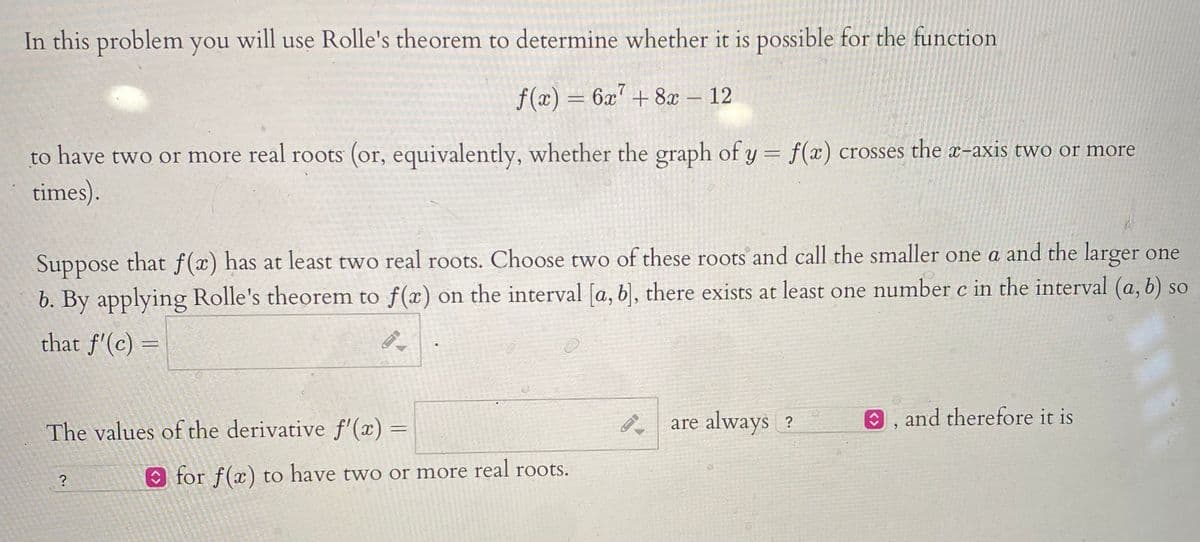In this problem you will use Rolle's theorem to determine whether it is possible för the function f(x) = 6x"+8x – 12 to have two or more real roots (or, equivalently, whether the graph of y = f(x) crosses the x-axis two or more times). Suppose that f(x) has at least two real roots. Choose two of these roots and call the smaller one a and the larger one b. By applying Rolle's theorem to f(x) on the interval [a, b), there exists at least one numberc in the interval (a, b) so that f'(c) = The values of the derivative f'(x) = are always ? and therefore it is O for f(x) to have two or more real roots.
In this problem you will use Rolle's theorem to determine whether it is possible för the function f(x) = 6x"+8x – 12 to have two or more real roots (or, equivalently, whether the graph of y = f(x) crosses the x-axis two or more times). Suppose that f(x) has at least two real roots. Choose two of these roots and call the smaller one a and the larger one b. By applying Rolle's theorem to f(x) on the interval [a, b), there exists at least one numberc in the interval (a, b) so that f'(c) = The values of the derivative f'(x) = are always ? and therefore it is O for f(x) to have two or more real roots.
Glencoe Algebra 1, Student Edition, 9780079039897, 0079039898, 2018
18th Edition
ISBN:9780079039897
Author:Carter
Publisher:Carter
Chapter9: Quadratic Functions And Equations
Section9.2: Transformations Of Quadratic Functions
Problem 50PFA
Related questions
Question
All boxes

Transcribed Image Text:In this problem you will use Rolle's theorem to determine whether it is possible for the function
f(x) = 6x7 + 8x
12
to have two or more real roots (or, equivalently, whether the graph of y = f(x) crosses the x-axis two or more
times).
Suppose that f(x) has at least two real roots. Choose two of these roots and call the smaller one a and the larger one
b. By applying Rolle's theorem to f(x) on the interval [a, b, there exists at least one number c in the interval (a, b) so
that f'(c) =
The values of the derivative f'(x) =
P are always ?
0, and therefore it is
?
O for f(x) to have two or more real roots.
Expert Solution
This question has been solved!
Explore an expertly crafted, step-by-step solution for a thorough understanding of key concepts.
This is a popular solution!
Trending now
This is a popular solution!
Step by step
Solved in 2 steps with 2 images

Recommended textbooks for you

Glencoe Algebra 1, Student Edition, 9780079039897…
Algebra
ISBN:
9780079039897
Author:
Carter
Publisher:
McGraw Hill

Algebra for College Students
Algebra
ISBN:
9781285195780
Author:
Jerome E. Kaufmann, Karen L. Schwitters
Publisher:
Cengage Learning

Algebra & Trigonometry with Analytic Geometry
Algebra
ISBN:
9781133382119
Author:
Swokowski
Publisher:
Cengage

Glencoe Algebra 1, Student Edition, 9780079039897…
Algebra
ISBN:
9780079039897
Author:
Carter
Publisher:
McGraw Hill

Algebra for College Students
Algebra
ISBN:
9781285195780
Author:
Jerome E. Kaufmann, Karen L. Schwitters
Publisher:
Cengage Learning

Algebra & Trigonometry with Analytic Geometry
Algebra
ISBN:
9781133382119
Author:
Swokowski
Publisher:
Cengage


Big Ideas Math A Bridge To Success Algebra 1: Stu…
Algebra
ISBN:
9781680331141
Author:
HOUGHTON MIFFLIN HARCOURT
Publisher:
Houghton Mifflin Harcourt
